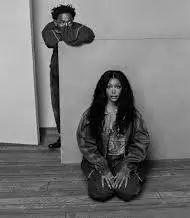by Anton Dedvukaj
Hello everyone, and welcome to “Mic Drop”. During the first week of December, Billboard’s Year-End Charts were released. 2021’s year end charts, as always, cover everything from singles to albums to artists, and as mentioned in the last “Mic Drop”, we’ll be taking a look at what made the lists, and providing an overview of what the music scene of 2021 had to offer.
To start, let’s take a look at the singles charts. As I previously predicted, the number-one song of the year was Dua Lipa’s “Levitating”. This song holds a number of unique distinctions because of its placement. For starters, it’s the first song since 2001 to top the Year End without topping the weekly Hot 100, as it peaked at No. 2 for a week in May. It also becomes the first song by a solo female artist to top the Year End since 2011, where Adele topped that year’s list with “Rolling in the Deep”.
Below that, we have a double-feature from The Weeknd. At No. 2 is “Save Your Tears” with Ariana Grande, and at No. 3 is last year’s No. 1 song, “Blinding Lights”. The latter is the first song to feature in two year-end top 10 lists since “Closer” in 2016 and 2017, and the first song in history to rank among the top three biggest songs of the year twice. It was also recently crowned the biggest hit of all time in terms of chart performance by Billboard a few weeks ago.
Continuing down the top 10, you’ll find a number of huge hits. They are as follows:
No. 4: Mood – 24kGoldn feat. iann dior (up from No. 47 last year)
No. 5: good 4 u – Olivia Rodrigo
No. 6: Kiss Me More – Doja Cat feat. SZA
No. 7: Leave the Door Open – Silk Sonic
No. 8: drivers license – Olivia Rodrigo
No. 9: MONTERO (Call Me By Your Name) – Lil Nas X
No. 10: Peaches – Justin Bieber feat. Daniel Caesar & Giveon
Normally, like with last year, I’d try to find a way to connect the music of the year with the year’s general mood. Last year, I highlighted the fact that there was so much 2019 music on the Year End, and pointed that towards a desire for escapism felt by many in 2020. That, obviously, wouldn’t apply here. No songs have ever made three Year End lists, so it’s not like any 2019 hits are still here.
I think that we can still try to make a connection to the year’s mood, however. 2021 can be defined as a “transitional” year for music, where the music of the late 2010s and the pandemic period faded out, to be replaced with the type of music that may come to define the 2020s. It’s similar to how 2011 and 2012 served as transitional years, trading the wave of club-centered music from the late 2000s and 2010 with a more prominent indie rock and EDM boom that came to define the early-to-mid-2010s.
I’ll be looking at each genre and seeing how they fared this year, as well as taking notice of any change in performance I saw from last year to this year. Genre is a fairly subjective term, so I’ll be using Billboard’s definition of genre as defined by their genre charts, flawed as I feel those definitions to be.
First off, pop and rap. Pop saw a fair amount of success this year, as evidenced by the top ten, where several songs within it- including the year’s biggest hit – were pop songs. Rap was also successful, but there has been a notable decline in popularity for the genre, especially since 2017 and 2018, the first two years I started following the charts. Back then, rap was inescapable in the upper reaches of the Year End, but this year, only two songs in the top 20 – “Mood” and “Astronaut in the Ocean” – are labeled as rap.
That’s not to say it didn’t have a notable presence – 30 songs in the top 100 are still rap songs – but it mainly tended to be in the middle of the Year End as opposed to the top.
Speaking of genres with low representation, let’s look at two genres that are huge worldwide but were underrepresented in the United States, Latin and dance music. For Latin music, only four songs made the list, and even that’s a significant improvement over last year, which only had one Latin song, and one that had a prominent English section at that, make the list. Still, that’s better than dance music, which legitimately had zero songs represented on the Year End.
These two genres having such low representation is especially surprising when you look at the Global 200 Year End, which Billboard also published. I’ve followed the charts in countries such as Canada, the UK, and Australia this year as well, and EDM was huge this year in these countries. At least with Latin music, which was also big this year globally, the language barrier can account for the reasons why it didn’t cross over as much. Given that most of the popular EDM this year was in English, this only makes its absence from the Year End so much more notable.
Now to genres that actually saw some increase in popularity. One genre that has had a lot of growth in representation in recent years is R&B. Three R&B songs, “Blinding Lights”, “Leave the Door Open”, and “Peaches”, ranked in the top ten. Eleven R&B songs made the Year End in total, with other notable hits from the genre this year including “Go Crazy”, “HEARTBREAK ANNIVERSARY”, “You Right”, and “You’re Mines Still”.
Next up, rock and alternative music. As I previously covered on “Mic Drop”, it’s very debatable whether the majority of these songs are rock music, but going by Billboard’s definition, rock had a good year. As opposed to the six rock songs that made the Year End last year, we had nine songs make it this year, led by “Mood”, “Heat Waves”, and “WITHOUT YOU” in the top 20.
Finally, we have country music, which had another fairly solid year. There were three country songs in the top 40 this year, being “Forever After All”, “Fancy Like”, and “I Hope”. All three of these songs peaked within the top three of the Hot 100 as well. There were nineteen country songs on this year’s list, with the majority, as always, ranking within the bottom half of the list.
Elsewhere, on the album charts, country music had a much more solid showing. Namely, the No. 1 album of the year – Morgan Wallen’s “Dangerous: The Double Album” – was a country album. It’s the first country album to top the Year End Albums chart since “Fearless” by Taylor Swift did so in 2009. It was followed by Olivia Rodrigo’s debut album “SOUR” at No. 2, the late Pop Smoke’s “Shoot For the Stars Aim For the Moon” at No. 3, Taylor Swift’s “evermore” at No, 4, and Drake’s “Certified Lover Boy” at No. 5.
Finally, the Top Artists year end list, which combines singles and albums performances, was released, with Drake ranking first. It’s the second time he’s topped this list, with the first being in 2018.
He owes his high chart placement due to the combined success of his wide catalog of six studio albums, especially “Certified Lover Boy”, and many singles. Such singles include those from “Certified Lover Boy”, such as “Way 2 Sexy” and “Knife Talk”, those from his Scary Hours 2 EP, such as “What’s Next” and “Wants and Needs”, and many other collaborations, such as “Laugh Now Cry Later” with Lil Durk and “You’re Mines Still” with Yung Bleu. All of these songs also made the Year End Hot 100.
Next on the artist Year End is Olivia Rodrigo, who scored massive success on the singles chart, namely with her two number one singles and two additional top ten hits. Following her was The Weeknd, who scored two of the three biggest songs this year, had several more lower-charting hits, and enjoyed the continued success of his 2020 album, “After Hours”.
Overall, this year was a varied one for music. Many genres got a fair amount of representation in the music scene, and I’d even argue that 2021 has been more of a transitional year than anything else, as we rid the charts of their 2010s influence and usher in the new sounds of the 2020s. I’m very excited to see what 2022 holds, especially as I’d argue that 2020 and 2021 were both very good years for popular music, if nothing else. Here’s to more great music to get us through the next year.









Be First to Comment